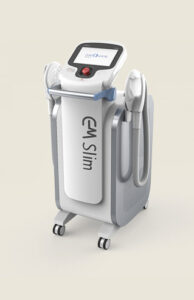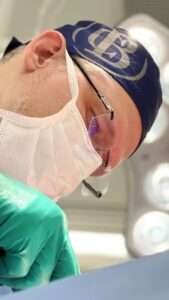

Gluteal Prosthesis (Gluteoplasty)
Silicone for buttock augmentation
Gluteal augmentation surgery consists of placing a silicone prosthesis, of a predefined size and shape, in a space created inside the gluteal muscles bilaterally.
It is performed through an incision (cut), which will leave a final scar, in the intergluteal groove, i.e. between the buttocks, close to the coccyx.
Silicone implants are produced by a number of national and international companies, all with roughly the same qualities and with little variation in price.
Because they are made of inorganic material, prostheses cause few reactions in the human body. Those that can occur are called foreign body reactions, which aim to isolate the implant by creating a fibrous (cicatricial) membrane or capsule around it.
To improve the result obtained with buttock augmentation, liposuction of certain areas may be indicated to improve the contour of the buttocks. Liposuction is explained in a separate section.
Further information about the Gluteal Prosthesis
- Silicone implants do not cause cancer or any other disease. After the gluteal implants have been inserted, intramuscular medication (injections) into the buttocks is contraindicated.
- If changes occur in the buttocks after the prosthesis has been fitted, ultrasound, CT or MRI scans may be necessary to clarify the diagnosis.
- Trauma to the buttocks not only puts mechanical stress on the prostheses, which can lead to them breaking, but can also accelerate the process of capsular contracture or cause herniations, seromas or hematomas that may need to be treated. Scars evolve according to individual physiology and are usually barely noticeable, especially in the penumbra. If changes occur, there are treatments that can be used in an attempt to improve the appearance of the scars.
- Purple spots (ecchymoses) may occur.
- It is recommended to sleep on your stomach for the first few nights and to sit and stand up with assistance for the first 15 days so as not to strain the gluteal muscles.
- The purpose of this surgery is to enlarge the gluteal region. Small excesses of skin that cause gluteal flaccidity may not be resolved, requiring a new assessment with the possibility of surgical re-intervention for skin resection and consequent scarring.
Pre-operative gluteal augmentation surgery
- 1. Obey the instructions given for admission
- 2. Report any abnormalities that may occur in their general condition.
- 3. INFORM YOUR SURGEON OF THE SLIGHTEST POSSIBILITY OF PREGNANCY. DO NOT STOP USING CONTRACEPTIVE METHODS.
- 4. Enter hospital fasting for at least 8 hours and do not bring valuables into the hospital.
- 5. Come accompanied to the hospital.
- 6. Avoid wearing earrings, rings, piercings, colored nail polish, etc. Any of these will be removed before surgery.
- 7. The recommended belt should be taken to the hospital.
Post-operative gluteal augmentation surgery
- 1. avoid exertion for 30 days.
- 2. Sitting and standing up with assistance
- 3. Get up as many times as recommended on discharge from hospital, observing the periods of sitting and avoiding maximum effort.
- 4. Do not expose yourself to the sun or cold for at least 14 days.
- 5. Obey the doctor's prescription.
- 6. Return to the office for subsequent dressings, on the days and at the times stipulated.
- 7. Don't worry about the intermediate forms in the various phases. Ask your surgeon any questions you may have.
- 8. Normal diet (except in special cases). We recommend a high-protein diet (meat, eggs, milk) as well as fruit.
- 9. Wait to go on your "diet or slimming regime" once you've been cleared by your doctor. Anticipating such conduct on your own could lead to difficult consequences.
Other body procedures
Before and after - Buttock prosthesis
Surgeries and procedures performed by Dr. Celso Boechat
Other Plastic Surgeries in Rio de Janeiro
From stunning beaches to vibrant aesthetics, discover the plastic surgeries that reflect Rio de Janeiro’s beautiful spirit and dynamic aesthetic standards.
Breast surgery
Raise your self-esteem, reaffirm your beauty.
Body Surgeries
Transformations for your ideal body.
Facial surgery
Facial renewal, bring out your true expression.
Frequently asked questions about buttock silicone
Buttock augmentation: The most asked questions about buttock augmentation surgery
Like any surgery, silicone butt implants come with risks, such as infection, bleeding, rejection of the implant, asymmetry or changes in the sensitivity of the area. It is important to discuss these aspects with the surgeon before the procedure.
Yes, it is possible to remove or replace silicone buttocks prostheses if necessary, whether for aesthetic or medical reasons. The removal or replacement process should be discussed with a qualified plastic surgeon.
During the preoperative period, it is important to carry out tests to check your general health and ensure that the surgery goes smoothly. In the post-operative period, following medical guidelines is essential, including rest, taking prescribed medication and avoiding intense physical exertion.
Yes, after the recovery period and medical clearance, it is possible to return to physical activities, including weight training. However, during the first few weeks after surgery, it is important to avoid intense physical exertion, especially in the gluteal region.
People who are healthy, at their ideal weight and want to increase the size or improve the shape of their buttocks may be candidates for the procedure. However, it is important to undergo medical assessment to determine the feasibility and safety of the surgery.
The results of the silicone buttock implant can be seen after approximately 15 days, with a reduction in swelling. The definitive results, however, can take up to two months to become completely visible.
Possible risks of buttock augmentation
GLUTEOPLASTY, like any other surgery, has risks and complications, some of which are specific to it and others which are generic to any type of surgery. These include:
Generic
1. Allergies: Some medications or products used during surgery can cause allergic reactions, which can even lead to death. Allergic reactions are patient-dependent and can occur either to medicines or products that the patient has never had contact with, or to those that they have had previous contact with, even if they didn’t have a previous reaction.
2. Infection: Our body is colonized by countless bacteria, with which, at first, we live in extreme harmony. However, after surgery, they can cause infection, requiring treatment with antibiotics and rarely re-operation. In the case of prostheses, the prosthesis may be lost, but can be reinserted once the process has healed.
3. Hematoma: Accumulation of blood in the operated area, from a vessel that was not bleeding at the end of the operation, but did so in the immediate post-operative period. It can be treated by aspiration with a syringe and needle or, rarely, re-operation may be necessary.


Book your appointment
Find out everything you need in one consultation
Possible risks of buttock augmentation
GLUTEOPLASTY, like any other surgery, has risks and complications, some of which are specific to it and others which are generic to any type of surgery. These include:
Generic
1. Allergies: Some medications or products used during surgery can cause allergic reactions, which can even lead to death. Allergic reactions are patient-dependent and can occur either to medicines or products that the patient has never had contact with, or to those that they have had previous contact with, even if they didn’t have a previous reaction.
2. Infection: Our body is colonized by countless bacteria, with which, at first, we live in extreme harmony. However, after surgery, they can cause infection, requiring treatment with antibiotics and rarely re-operation. In the case of prostheses, the prosthesis may be lost, but can be reinserted once the process has healed.
3. Hematoma: Accumulation of blood in the operated area, from a vessel that was not bleeding at the end of the operation, but did so in the immediate post-operative period. It can be treated by aspiration with a syringe and needle or, rarely, re-operation may be necessary.
4. Seroma: Accumulation of oily liquid resulting from the liquefaction of manipulated fatty tissue. It can’t be predicted. It can be treated by aspiration with a syringe and needle or, rarely, re-operation may be necessary.
5. Thrombosis: Any surgical procedure can lead to venous thrombosis. This can be predicted in predisposed patients, but can also occur in healthy patients without any predisposing factors.
Specific
(1) Epidermolysis: This is the loss of the superficial layer of skin around the surgical incision. It is caused by the prosthesis rubbing against the skin during positioning.
2. Contracture: This consists of a reduction in the size of the fibrous capsule surrounding the prosthesis. It’s a normal reaction of the body. It changes the shape of the breast and can cause pain. It can occur over a variable period of time (from 2 months to 20 years). It is less common with textured prostheses and even less common with polyurethane prostheses.
3. Breakage: The silicone prosthesis is currently coated with a highly resistant, smooth silicone membrane and filled with a cohesive, highly viscous gel, which reduces the chances of leakage or migration. However, there is a chance that the capsule will rupture, displacing some of the silicone gel. It usually doesn’t leave the implant, but is contained by the fibrous capsule that the body creates around the implant. This can occur over a variable period of time, depending on the mechanical stress to which the prosthesis will be subjected. The average term is 10 years. Replacing the implant is recommended, but not mandatory.
4. Extrusion: This is the expulsion of the implant from the body, through the skin. This is a rare occurrence, which can mainly be associated with other complications, such as infection or capsular contracture.
5. Herniation: Occurs rarely, when the silicone implant protrudes between the muscle fibers, creating bulges in the upper lateral segment of the buttocks. Correction requires re-operation.
6. Neuropraxia: Occurs due to compression of the sciatic nerve over the muscle. It can occur due to edema after surgery, which is reversible after a few days, or due to individual anatomical changes, where the nerve has its most superficial exit in the muscle. In both cases it may be necessary to remove the implants.


Appointment
Make an appointment and get your questions answered
Schedule an appointment with plastic surgeon Dr. Celso Boechat. Discover the path to aesthetic transformation and improved self-esteem. Our specialized team is ready to guide you through the procedure options, answering your questions and creating a personalized plan to suit your needs. Book your appointment now and take the first step towards a more confident and radiant version of yourself.
Send a message via WhatsApp
Service and consultations
Call Us
(21) 997336862
Opening hours
Monday to Friday - 09:00 - 21:00
Saturdays and Sundays - Closed, only for surgeries




